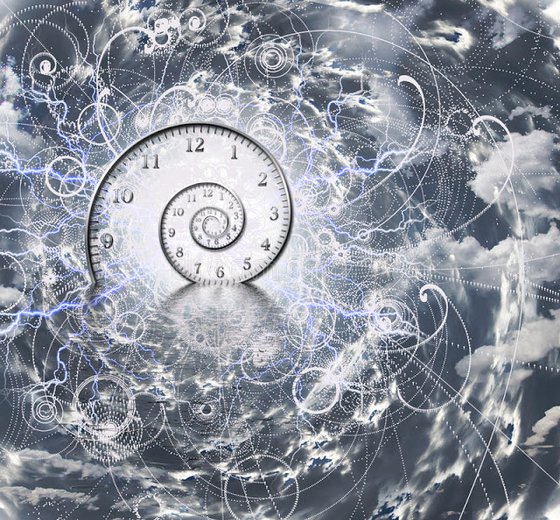FIRST THREE MINUTES 1

THE FIRST THREE MINUTES PART ONE
We are now prepared to follow the course of cosmic evolution through its first three minutes. Events move much more swiftly at first than later, so it would not be useful to show pictures spaced at equal time intervals, like an ordinary movie. Instead, I will adjust the speed of our film to the falling temperature of the universe, stopping the camera to take a picture each time that the temperature drops by a factor of about three.
Unfortunately, I cannot start the film at zero time and infinite temperature. Above a threshold temperature of fifteen hundred thousand million degrees Kelvin (1.5 X 1012 ° K), the universe would contain large numbers of the particles known as pi mesons, which weigh about one-seventh as much as a nuclear particle. (See Table One on p. 156.) Unlike the electrons, positrons, muons, and neutrinos, the pi mesons interact very strongly with each other and with nuclear particles—in fact, the continual exchange of pi mesons among nuclear particles is responsible for most of the attractive force which holds atomic nuclei together. The presence of large numbers of such strongly interacting particles makes it extraordinarily difficult to calculate the behavior of matter at super-high temperatures, so to avoid such difficult mathematical problems I will start the story in this chapter at about one-hundredth of a second after the beginning, when the temperature had cooled to a mere hundred thousand million degrees Kelvin, safely below the threshold temperatures for pi mesons, muons, and all heavier particles. With these understandings, let us now start our first frame.
The temperature of the universe is 100,000 million degrees Kelvin (10^11 ° K). The universe is simpler and easier to describe than it ever will be again. It is filled with an undifferentiated soup of matter and radiation, each particle of which collides very rapidly with the other particles. Thus, despite its rapid expansion, the universe is in a state of nearly perfect thermal equilibrium. The contents of the universe are therefore dictated by the rules of statistical mechanics, and do not depend at all on what went before the first frame. All we need to know is that the temperature is 10n ° K, and that the conserved quantities—charge, baryon number, lepton number—are all very small or zero.
The abundant particles are those whose threshold temperatures are below 10" ° K; these are the electron and its anti-particle, the positron, and of course the mass-less particles, the photon, neutrinos, and antineutrinos. (Again, see Table One on p. 156.) The universe is so dense that even the neutrinos,
which can travel for years through lead bricks without being scattered, are kept in thermal equilibrium with the electrons, positrons, and photons by rapid collisions with them and with each other. (Again, I will sometimes simply refer to "neutrinos" when I mean neutrinos and antineutrinos.)
Another great simplification—the temperature of (10^11) ° K is far above the threshold temperature for electrons and positrons.It follows that these particles, as well as the photons and neutrinos, are behaving just like so many different kinds of radiation. What is the energy density of these various kinds of radiation? According to Table One on page 156, the electrons and positrons together contribute 7/4 as much energy as the photons, and the neutrinos and antineutrinos contribute the same as the electrons and positrons, so the total energy density is greater than the energy density for pure electromagnetic radiation at this temperature, by a factor
(7/4 + 7/4 + 1) = 9/2
The Stefan-Boltzmann law (see Chapter III) gives the energy density of electromagnetic radiation at a temperature of 10" ° K as 4.72 x 1044 electron volts per liter, so the total energy density of the universe at this temperature was 9/2 as great, or 21 x 1044 electron volts per liter. This is equivalent to a mass density of 3.8 thousand million kilograms per liter, or 3.8 thousand million times the density of water under normal terrestrial conditions. (When I speak of a given energy as being equivalent to a given mass, I mean of course that this is the energy that would be released according to the Einstein formula E=mc^2, if the mass were converted entirely to energy.) If Mt. Everest were made of matter this dense, its gravitational attraction would destroy the earth.
The universe at the first frame is rapidly expanding and cooling. Its rate of expansion is set by the .condition that every bit of the universe is traveling just at escape velocity away from any arbitrary center. At the enormous density of the first frame, the escape velocity is correspondingly high—the characteristic time for expansion of the universe is about 0.02 seconds. (See mathematical note 3, p. 171. The "characteristic expansion time" can be roughly defined as 100 times the length of time in which the size of the universe would increase 1 percent. To be more precise, the characteristic expansion time at any epoch is the reciprocal of the Hubble "constant" at that epoch. The age of the universe is always less than the characteristic expansion time, because gravitation is continually slowing down the expansion.)
There are a small number of nuclear particles at the time of the first frame, about one proton or neutron for every 1,000 million photons or electrons or neutrinos. In order eventually to predict the abundances of the chemical elements formed in the early universe, we will also need to know the relative proportions of protons and neutrons. The neutron is heavier than the proton, with a mass difference between them equivalent to an energy of 1.293 million electron volts. However, the characteristic energy of the electrons, positrons, and so on, at a temperature of 10" ° K is much larger, about 10 million electron volts (Boltzmann's constant times the temperature). Thus, collisions of neutrons or protons with the much more numerous electrons, positrons, and so on, will produce rapid transitions of protons to neutrons and vice versa. The most important reactions are
Antineutrino plus proton yields positron plus neutron (and vice versa)
Neutrino plus neutron yields electron plus proton (and vice versa)
Under our assumption that the net lepton number and charge per photon are very small, there are almost exactly as many neutrinos as antineutrinos, and as many positrons as electrons, so that the transitions from proton to neutron are just as fast as the transitions from neutron to proton. (The radioactive decay of the neutron can be ignored here because it takes about 15 minutes, and we are working now on a time scale of hundredths of seconds.) Equilibrium thus requires that the numbers of protons and neutrons be just about equal at the first frame. These nuclear particles are not yet bound into nuclei; the energy required to break up a typical nucleus altogether is only six to eight million electron volts per nuclear particle; this is less than the characteristic thermal energies at
10^11 °K, so complex nuclei are destroyed as fast as they form.
It is natural to ask how large the universe was at very early times. Unfortunately we do not know, and we are not even sure that this question has any meaning. The universe may well be infinite now, in which case it was also infinite at the time of the first frame, and will always be infinite. On the other hand, it is possible that the universe now has a finite circumference, sometimes estimated to be about 125 thousand million light years. (The circumference is the distance one must travel in a straight line before finding oneself back where one started. This estimate is based
on the present value of the Hubble constant, under the supposition that the density of the universe is about twice its "critical" value.) Since the temperature of the universe falls in inverse proportion to its size, the circumference of the universe at the time of the first frame was less than at present by the
ratio of the temperature then (1011 ° K) to the present temperature (3° K); this gives a first-frame circumference of about four light years. None of the details of the story of cosmic evolution in the first few minutes will depend on whether the circumference of the universe was infinite or only a few light years.
 A HISTORICAL DIVERSION BY STEVEN WEINBERG 1
A HISTORICAL DIVERSION BY STEVEN WEINBERG 1

Hope is the bedrock of this nation. The belief that our destiny will not be written for us, but by us, by all those men and women who are not content to settle for the world as it is, who have the courage to remake the world as it should be.
---Barack Obama




